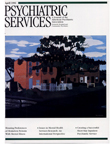Neighborhood locations of Section 8 housing certificate users with and without mental illness
Abstract
OBJECTIVE. The study examined whether participants with mental illness in the federal Section 8 housing subsidy program settle in neighborhoods different from those of Section 8 participants without mental illness. The nature of these differences and the reasons they occur were also examined. METHODS. Data sources included the Section 8 survey for Baltimore and Cincinnati of the national evaluation of the Robert Wood Johnson Foundation Program on Chronic Mental Illness, police records, and 1990 census tract files, supplemented with the addresses of all Section 8 users and mental health services in both cities. Analyses consisted of calculations of dissimilarity indexes, comparisons of means, and multiple regressions. RESULTS. Dissimilarity index scores were .54 for Baltimore and .48 for Cincinnati, indicating that roughly half of all Section 8 users with mental illness would have to move to eliminate neighborhood disparities between them and Section 8 users without mental illness. Section 8 users with mental illness settled in somewhat better neighborhoods than those without mental illness. This finding was largely attributable to the sizable disparities in the racial composition of the two groups of Section 8 users: a greater proportion of users with mental illness were white. CONCLUSIONS. The neighborhood quality of Section 8 users with mental illness was found to be at least as high as that for users without mental illness. It is not clear whether the Section 8 program of the Program on Chronic Mental Illness disproportionately served whites, although the racial composition of the Section 8 program in both cities is disproportionately black.
Access content
To read the fulltext, please use one of the options below to sign in or purchase access.- Personal login
- Institutional Login
- Sign in via OpenAthens
- Register for access
-
Please login/register if you wish to pair your device and check access availability.
Not a subscriber?
PsychiatryOnline subscription options offer access to the DSM-5 library, books, journals, CME, and patient resources. This all-in-one virtual library provides psychiatrists and mental health professionals with key resources for diagnosis, treatment, research, and professional development.
Need more help? PsychiatryOnline Customer Service may be reached by emailing [email protected] or by calling 800-368-5777 (in the U.S.) or 703-907-7322 (outside the U.S.).



